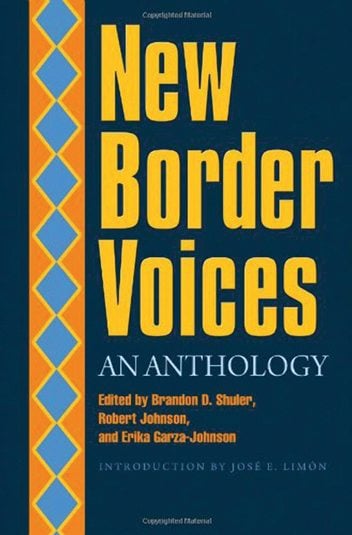
New Border Voices Reflects Life in a Third Space
A version of this story ran in the October 2014 issue.
The Texas-Mexico Borderlands are like tequila in my bloodstream: at times memorable, at times unfavorable, but always running strong and hot. My great-grandfather was murdered in Ciudad Acuña, just across the border from Del Rio. I fell in love there with a girl while we slow-danced to Los Tigres del Norte in the Corona Cafe. Mexican Immigration once detained me for nearly 10 hours, then released me without asking for proof of citizenship. I drank vampiros with a 70-year-old man named Hormiga who claimed to be a local drug kingpin. The Borderlands are in my DNA.
You won’t find the Borderlands marked as a spot or shape on a map. Consider it a third space, one that is neither Texas nor Mexico, but contains the blood, voices and language of both, and those of many other peoples and cultures, with a history as long as the Rio Grande’s path between Texas and the Mexican states of Chihuahua, Coahuila, Nuevo León and Tamaulipas. Identity in the Borderlands is complex, open to examination. Enter New Border Voices, a collection of stories, poems and essays that reflect the variegated narratives found in this third space.

Edited by Brandon D. Shuler, Robert Johnson and Erika Garza-Johnson
Texas A&M University Press
292 pages; $25.00 Texas A&M University Press
The anthology opens with a reprint of José E. Limón’s essay “A ‘Southern Renaissance’ for Texas Letters,” first published more than 25 years ago. Limón sets the tone for the anthology by pointing out that Texas literature “does not stop at the Nueces.” Nor does it stop at the Rio Grande (or el Rio Bravo del Norte, as it’s known to many Borderlanders). The writers in New Border Voices are gathered from both sides and stretch across generations.
Many years ago, as a student, I sat in Rolando Hinojosa-Smith’s Southwestern Literature class at the University of Texas and discovered his Klail City Death Trip series—short novels set on the Texas-Mexico divide that exemplify Borderland life. New Border Voices includes his classic essay “The Texas-Mexico Border: This Writer’s Sense of Place,” in which Hinojosa-Smith not only establishes the Borderlands as more than a dyad, but also addresses the mosaic of identity one finds there: “We were Borderers with a living and unifying culture born of conflict with another culture,” he writes. “This … helped to cement further still the knowledge of exactly where one came from and from whom one was descended.”
These links to the past (Limón, Hinojosa-Smith) lend the anthology context, but the book’s primary focus, as it should be, is on writers who depict the Borderlands in the 21st century.
Mexican writer Agustín Cadena’s short story “The Border is a Good Place to Live” opens with working-class humility: “I tell everyone who comes through here and asks that the border is a good place to live,” he writes. “There’s work, I tell them. Besides, houses are cheap, cars are cheap, and you never get bored: when there’s prohibition on this side, you go to the other; when there’s prohibition on the other side, people come over here.” But Cadena’s tale of a motel worker shifts into tragedy when the narrator falls in love with a gringa who abandons him for El Norte. The story goes on to highlight the survivalist mentality one must possess in order to exist in the Borderlands.
But New Border Voices contains more than just dirty realism. It is also full of love letters to and about the region, presented in styles and voices as diverse as the landscape between Brownsville and Ciudad Juárez. Rodney Gomez’s “Serape”—in which the titular wrap is described as being “smooth as axolotl skin”—captures a lonely desert sensibility in sparse lines. “It’s frightening to know how quickly a man without belief will disappear,” Gomez writes. “All that was left was a desert, dense with thirst. This is what happens when you unravel a thing already unraveled—the body finds another body to cover its void.”
And we should listen. Because even though the Texas-Mexico border is designated by law as a demarcation between two countries, two cultures, two languages, and even though, as Ben Roberts writes so eloquently in “Escalera,” the U.S. has built a “wall higher, higher than any ladder, [made] a monument of the wall, a memorial” of barbed-wire fences and checkpoints, and used it to split the souls of Texas and Mexico, blood speaks because people speak. The marrow of Borderland identity is neither here nor there but in between, metastasizing and echoing throughout, wall or not.
In “Where Are You Home?” poet Brenda Nettles Riojas asks, “Why am I still searching / when Texas, they say / is home?” This searching is an inextricable part of life in the Borderlands, a place of strict rules, negotiable rules and imagined rules; a place of mercados vibrantes and international trade (despite NAFTA’s failings); of Martha Washington-inspired debutante balls, graveyards of murdered women and maquiladoras; of elote en vaso, the Old Kentucky Club and the real margarita (tequila with a squeeze of lime); a place suffering an overstated border crisis; and of people—just people—crossing back and forth, north to south, south to north, to work, to play, to live.
New Border Voices offers a glimpse into this world populated by what Hinojosa-Smith calls “Borderers,” a world with which readers would do well to become familiar. This writing, and this anthology, as poet Tammy Melody Gomez suggests in her poem “Ojos de Dios,” is “for you / you must, you have to carry it with you. / It’s small and will not take so much space, / in your pocket or around your neck, let it be carried to help you.”
To support journalism like this, donate to the Texas Observer.


